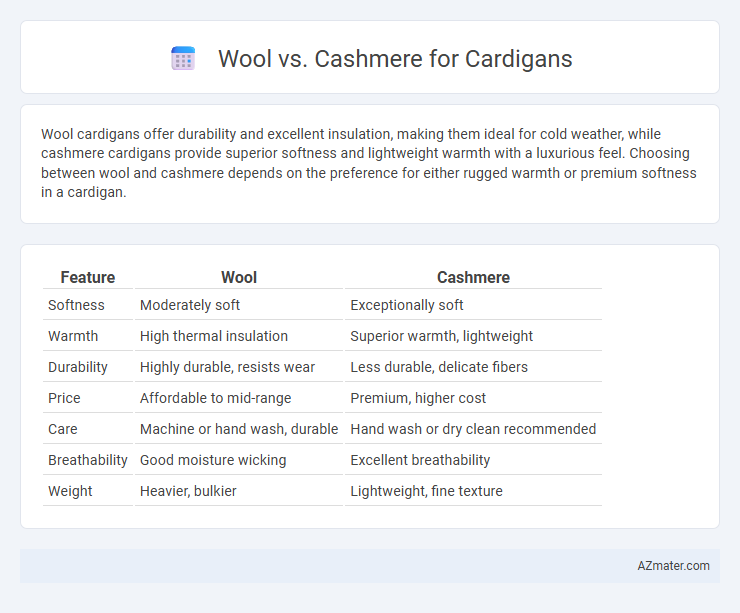Wool cardigans offer durability and excellent insulation, making them ideal for cold weather, while cashmere cardigans provide superior softness and lightweight warmth with a luxurious feel. Choosing between wool and cashmere depends on the preference for either rugged warmth or premium softness in a cardigan.
Table of Comparison
| Feature | Wool | Cashmere |
|---|---|---|
| Softness | Moderately soft | Exceptionally soft |
| Warmth | High thermal insulation | Superior warmth, lightweight |
| Durability | Highly durable, resists wear | Less durable, delicate fibers |
| Price | Affordable to mid-range | Premium, higher cost |
| Care | Machine or hand wash, durable | Hand wash or dry clean recommended |
| Breathability | Good moisture wicking | Excellent breathability |
| Weight | Heavier, bulkier | Lightweight, fine texture |
Introduction: Wool vs Cashmere for Cardigans
Wool cardigans are prized for their durability, excellent insulation, and moisture-wicking properties, making them ideal for everyday wear and colder climates. Cashmere cardigans offer unmatched softness, lightweight warmth, and a luxurious feel, preferred for comfort and elegance. Comparing wool and cashmere highlights key differences in fiber origin, texture, warmth, and price, guiding consumers in selecting the perfect cardigan material.
Understanding Wool: Key Characteristics
Wool, derived from sheep fleece, is known for its durability, excellent insulation, and moisture-wicking properties, making it a practical choice for cardigans. It offers natural elasticity and breathability, ensuring comfort and shape retention over time. Compared to cashmere, wool tends to be coarser but provides superior warmth and resistance to wear, ideal for long-lasting outerwear.
The Allure of Cashmere: What Sets It Apart
Cashmere cardigans offer unparalleled softness and warmth compared to traditional wool, thanks to the fine fibers sourced from cashmere goats. This luxurious material is lightweight yet exceptionally insulating, making it ideal for comfortable layering without bulk. Its rarity and labor-intensive harvesting process contribute to a higher price point and exclusivity in knitwear collections.
Softness and Comfort: Which Feels Better?
Cashmere offers superior softness compared to regular wool, with its fine fibers providing a silky, smooth texture that feels gentle against the skin. Wool, while generally coarser, is highly breathable and offers excellent insulation, making it comfortable for varied climates but potentially scratchy for sensitive skin. For those prioritizing plush comfort and a luxurious feel in a cardigan, cashmere is often preferred, whereas wool delivers durability and warmth with a slightly rougher touch.
Warmth and Insulation Comparison
Cashmere cardigans provide superior warmth and insulation compared to traditional wool due to their finer fibers, which trap heat more effectively while remaining lightweight. Wool cardigans, especially those made from merino or Shetland wool, offer excellent insulation but tend to be heavier and can sometimes feel coarser against the skin. For optimal warmth with a soft texture, cashmere stands out as the premium choice in cardigan materials.
Durability: Longevity of Wool vs Cashmere Cardigans
Wool cardigans are known for their superior durability, offering long-lasting wear due to their dense fiber structure and natural resilience, which helps resist pilling and shedding over time. Cashmere cardigans, while exceptionally soft and luxurious, tend to be more delicate and require careful handling to maintain their quality, as the finer fibers are more prone to wear and damage. Investing in wool cardigans typically results in greater longevity, making them ideal for everyday use compared to the more fragile nature of cashmere.
Maintenance and Care Requirements
Wool cardigans require regular brushing and airing to prevent pilling and maintain freshness, with hand washing or delicate machine cycles recommended using cold water and mild detergent. Cashmere cardigans demand even gentler care, including frequent gentle hand washing or dry cleaning to preserve the fibers, along with careful drying flat to avoid stretching or distortion. Both fibers benefit from proper storage in breathable garment bags and occasional de-pilling to extend cardigan longevity.
Price and Value Considerations
Wool cardigans typically offer a more affordable price point, making them accessible for everyday wear while providing durability and warmth. Cashmere cardigans command higher prices due to their luxurious softness and superior insulation, often perceived as a long-term investment in comfort and style. Evaluating value involves balancing initial cost with factors like fabric quality, lifespan, and overall comfort to determine the best option for individual needs.
Sustainability and Ethical Sourcing
Cashmere cardigans often raise sustainability concerns due to overgrazing by goats, which leads to soil erosion and habitat loss, while wool sourced from well-managed farms supports regenerative grazing practices that preserve ecosystems. Ethical sourcing of wool involves transparency in animal welfare, fair labor conditions, and traceability, often certified by organizations like Responsible Wool Standard (RWS). Choosing cardigans made from ethically sourced wool enhances sustainability by promoting animal welfare and reducing environmental impact compared to conventional cashmere.
Choosing the Right Material for Your Cardigan
Wool cardigans offer durability, warmth, and excellent moisture-wicking properties, making them ideal for everyday wear and colder climates. Cashmere cardigans provide superior softness, lightweight insulation, and luxury comfort but require more delicate care and are typically more expensive. Choosing between wool and cashmere depends on your priorities for warmth, texture, maintenance, and budget when selecting the perfect cardigan material.

Infographic: Wool vs Cashmere for Cardigan
 azmater.com
azmater.com